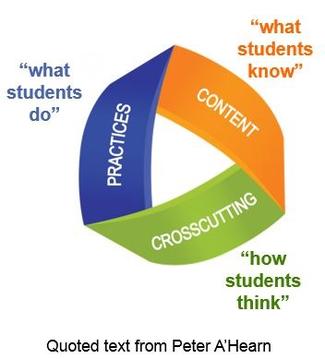Next Generation Science Standards (NGSS)
Why Next Generation Science Standards (NGSS)?
The world has changed dramatically in the 15 years since state science education standards’ guiding documents were developed. Since that time, many advances have occurred in the fields of science and science education, as well as in the innovation-driven economy. The U.S. has a leaky K–12 science, technology, engineering and mathematics (STEM) talent pipeline, with too few students entering STEM majors and careers at every level—from those with relevant post-secondary certificates to PhD’s. We need new science standards that stimulate and build interest in STEM. The current education system can’t successfully prepare students for college, careers and citizenship unless we set the right expectations and goals. While standards alone are no silver bullet, they do provide the necessary foundation for local decisions about curriculum, assessments, and instruction. Implementing the NGSS will better prepare high school graduates for the rigors of college and careers. In turn, employers will be able to hire workers with strong science-based skills—not only in specific content areas, but also with skills such as critical thinking and inquiry-based problem solving.
Cross-Cutting Concepts -
Crosscutting Concepts help students explore connections across the four domains of science, including Physical Science, Life Science, Earth and Space Science, and Engineering Design. When these concepts, such as “cause and effect”, are made explicit for students, they can help students develop a coherent and scientifically-based view of the world around them. The Crosscutting Concepts in the NGSS are:
- Patterns
- Cause and effect: mechanism and explanation
- Scale, proportion, and quantity
- Systems and system models
- Energy and matter: flows, cycles, and conservation
- Structure and function
- Stability and change
Science and Engineering Practices -
Science and Engineering Practices describe what scientists do to investigate the natural world and what engineers do to design and build systems. The practices better explain and extend what is meant by “inquiry” in science and the range of cognitive, social, and physical practices that it requires. Students engage in practices to build, deepen, and apply their knowledge of core ideas and crosscutting concepts. The eight practices of science and engineering that the Framework identifies as essential for all students to learn and describes in detail are listed below:
1. Asking questions (for science) and defining problems (for engineering)
2. Developing and using models
3. Planning and carrying out investigations
4. Analyzing and interpreting data
5. Using mathematics and computational thinking
6. Constructing explanations (for science) and designing solutions (for engineering)
7. Engaging in argument from evidence
8. Obtaining, evaluating, and communicating information
Disciplinary Core Ideas -
Disciplinary Core Ideas (DCIs) are the key ideas in science that have broad importance within or across multiple science or engineering disciplines. These core ideas build on each other as students progress through grade levels and are grouped into the following four domains: Physical Science, Life Science, Earth and Space Science, and Engineering.
NGSS Parent Resources
- NGSS Introduction and Overview
- Commonly Used Abbreviations
- How to Read the Next Generation Science Standards
- Infographic: How will Science Education Change with the NGSS
- Infographic: Science Education Needs an Update
- NGSS Fact Sheet
THE THREE DIMENSIONS OF SCIENCE LEARNING


